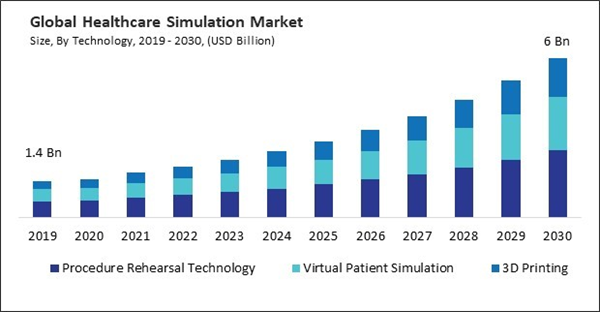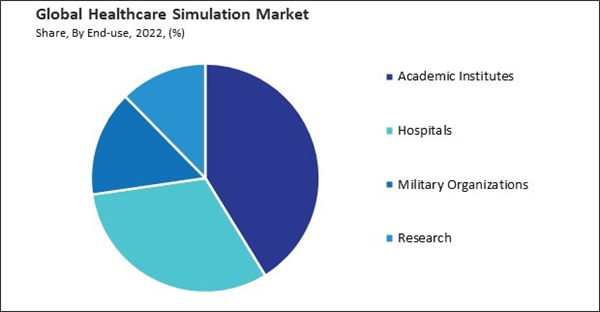The Global Healthcare Simulation Market size is expected to reach $6.0 billion by 2030, rising at a market growth of 15.5% CAGR during the forecast period.
Gynecological care often involves collaboration among multidisciplinary teams comprising obstetricians, gynecologists, reproductive endocrinologists, urogynecologists, radiologists, anesthesiologists, nurses, and support staff. Therefore, the gynecology simulators segment captured $54.6 million revenue in the market in 2022. Gynecology simulators support multidisciplinary team training exercises, interdisciplinary simulations, and collaborative learning experiences that simulate real-world clinical environments and promote interprofessional collaboration.
In many healthcare settings, there’s a scarcity of opportunities for students and healthcare professionals to interact with real patients due to various reasons such as privacy concerns, patient preferences, and limited clinical resources. Therefore, the shortage of clinical training opportunities drives the market’s growth.
Additionally, patient safety is paramount in healthcare, and simulation provides a controlled environment where healthcare professionals can learn and practice without putting real patients at risk. This allows learners to make mistakes, learn from them, and refine their skills without adverse consequences to patient safety. Thus, increasing focus on patient safety is propelling the market’s growth.
However, simulation equipment, including manikins, task trainers, virtual reality systems, and simulation software, can be expensive to purchase and maintain. The initial investment required to acquire these technologies can be prohibitive for many healthcare organizations, especially smaller clinics or educational institutions with limited budgets. Hence, high initial investment is impeding the growth of the market.
With restrictions on in-person gatherings and clinical rotations, healthcare education programs have increasingly turned to remote learning solutions, including virtual simulation platforms. Virtual simulation allows learners to engage in hands-on training activities from any location, enabling continuity of education during the pandemic. Thus, the COVID-19 pandemic positively impacted the market.
Gynecological care often involves collaboration among multidisciplinary teams comprising obstetricians, gynecologists, reproductive endocrinologists, urogynecologists, radiologists, anesthesiologists, nurses, and support staff. Therefore, the gynecology simulators segment captured $54.6 million revenue in the market in 2022. Gynecology simulators support multidisciplinary team training exercises, interdisciplinary simulations, and collaborative learning experiences that simulate real-world clinical environments and promote interprofessional collaboration.
In many healthcare settings, there’s a scarcity of opportunities for students and healthcare professionals to interact with real patients due to various reasons such as privacy concerns, patient preferences, and limited clinical resources. Therefore, the shortage of clinical training opportunities drives the market’s growth.
Additionally, patient safety is paramount in healthcare, and simulation provides a controlled environment where healthcare professionals can learn and practice without putting real patients at risk. This allows learners to make mistakes, learn from them, and refine their skills without adverse consequences to patient safety. Thus, increasing focus on patient safety is propelling the market’s growth.
However, simulation equipment, including manikins, task trainers, virtual reality systems, and simulation software, can be expensive to purchase and maintain. The initial investment required to acquire these technologies can be prohibitive for many healthcare organizations, especially smaller clinics or educational institutions with limited budgets. Hence, high initial investment is impeding the growth of the market.
With restrictions on in-person gatherings and clinical rotations, healthcare education programs have increasingly turned to remote learning solutions, including virtual simulation platforms. Virtual simulation allows learners to engage in hands-on training activities from any location, enabling continuity of education during the pandemic. Thus, the COVID-19 pandemic positively impacted the market.
By Interventional/Surgical Simulators Analysis
The interventional/surgical simulators segment is further subdivided into laparoscopic, gynecology, cardiovascular, arthroscopic, spine, and others. In 2022, the laparoscopic surgical simulators segment procured 32.1% revenue share in the market. Laparoscopic surgery requires surgeons to master intricate skills and techniques to manipulate specialized instruments and visualize internal structures using a camera system.By Technology Analysis
By technology, the market is segmented into procedure rehearsal technology, virtual patient simulation, and 3D printing. In 2022, the procedural rehearsal technology segment recorded 44.1% revenue share in the market. Procedural rehearsal technology allows healthcare professionals to practice and refine their procedural skills in a simulated environment before performing them on real patients.By End-use Analysis
Based on end-use, the market is categorized into academic institutes, hospitals, military organizations, and research. In 2022, the hospitals segment registered 31.5% revenue share in the market. Hospitals require healthcare professionals to possess various clinical skills to deliver high-quality patient care.By Product & Services Analysis
Based on product & services, the market is divided into healthcare anatomical models, web-based simulators, healthcare simulation software, and simulation training services. The healthcare simulation software segment attained 14.7% revenue share in the market in 2022. Healthcare simulation software provides a virtual platform for creating realistic and immersive simulation-based learning environments.By Healthcare Anatomical Models Analysis
The healthcare anatomical models segment is further divided into patient simulators, task trainers, interventional/surgical simulators, endovascular simulators, ultrasound simulators, dental simulators, and eye simulators. The task trainers segment attained 10.8% revenue share in the market in 2022. Task trainers offer focused and targeted training for specific skills or procedures.By Patient Simulators Analysis
On the basis of type, the patient simulators segment is divided into high fidelity, medium fidelity, and low fidelity. In 2022, the high fidelity segment attained 42.9% revenue share in the market. High-fidelity simulators leverage cutting-edge technology and sophisticated hardware and software components to simulate complex medical scenarios with high fidelity.By Regional Analysis
Region-wise, the market is analyzed across North America, Europe, Asia Pacific, and LAMEA. The North America region witnessed 42.6% revenue share in the market in 2022. North America, particularly the United States and Canada, boasts some of the world’s most advanced and well-established healthcare education systems.Recent Strategies Deployed in the Market
- 2024-Jan: CAE Inc. formed a partnership with SimHawk, a visionary SaaS platform in the area of ultrasound telemedicine. Through this partnership, the educational approach to ultrasound training was enhanced by combining SimHawk's didactic methods and motion-based practical learning with CAE's simulation using manikins. Additionally, this partnership optimized ultrasound learning by integrating various teaching methodologies.
- 2024-Jan: CAE Inc. came into a partnership GigXR Inc., a leading provider of extended reality (XR) solutions for healthcare training. Through this partnership, GigXR and CAE streamlined the implementation and management of multimodal simulation solutions across various sectors, including medical schools, nursing schools, hospital systems, first responders, and government agencies. Additionally, this collaboration covered analog, immersive, and digital modalities, enabling the creation of comprehensive curricula that cater to diverse learning needs and preferences.
- 2023-Dec: Mentice AB completed the acquisition of Biomodex, an innovative medical technology company. Through this acquisition, Mentice strengthened its position as the foremost provider of simulation solutions for image-guided interventional therapies, encompassing virtual, physical, and decision-support simulations.
- 2023-Nov: Intelligent Ultrasound Group PLC unveiled a novel AI development initiative, ScanNav FetalCheck, focused on gestational age estimation in prenatal care. The ScanNav FetalCheck scanning technology endeavours to empower users, whether skilled or non-skilled, to precisely determine gestational age (GA) with minimal training required.
- 2023-Jul: Limbs & Things Limited completed the acquisition of eoSurgical, a laparoscopic surgical trainer and software specialist. Through this acquisition, Limbs & Things integrated the innovative products of eoSurgical into its current lineup of laparoscopic trainers, substantially expanding its product range and market presence.
List of Key Companies Profiled
- CAE Inc.
- Laerdal Medical Limited
- Gaumard Scientific Company, Inc.
- Kyoto Kagaku Co., Ltd.
- Limbs & Things Limited
- Mentice AB
- Simulab Corporation
- Intelligent Ultrasound Group PLC
- Surgical Science Sweden AB
- Medical-X
Market Report Segmentation
By Technology- Procedure Rehearsal Technology
- Virtual Patient Simulation
- 3D Printing
- Academic Institutes
- Hospitals
- Military Organizations
- Research
- Healthcare Anatomical Models
- Patient Simulators
- High Fidelity
- Medium Fidelity
- Low Fidelity
- Interventional/Surgical Simulators
- Laparoscopic
- Gynecology
- Cardiovascular
- Arthroscopic
- Spine & Others
- Task Trainers
- Endovascular Simulators
- Ultrasound Simulators
- Dental Simulators
- Eye Simulators
- Web-Based Simulators
- Healthcare Simulation Software
- Simulation Training Services
- North America
- US
- Canada
- Mexico
- Rest of North America
- Europe
- Germany
- UK
- France
- Russia
- Spain
- Italy
- Rest of Europe
- Asia Pacific
- China
- Japan
- India
- South Korea
- Singapore
- Malaysia
- Rest of Asia Pacific
- LAMEA
- Brazil
- Argentina
- UAE
- Saudi Arabia
- South Africa
- Nigeria
- Rest of LAMEA
Table of Contents
Chapter 1. Market Scope & Methodology
Chapter 2. Market at a Glance
Chapter 3. Market Overview
Chapter 5. Global Healthcare Simulation Market by Technology
Chapter 6. Global Healthcare Simulation Market by End-use
Chapter 7. Global Healthcare Simulation Market by Product & Services
Chapter 8. Global Healthcare Simulation Market by Region
Chapter 9. Company Profiles
Companies Mentioned
- CAE Inc.
- Laerdal Medical Limited
- Gaumard Scientific Company, Inc.
- Kyoto Kagaku Co., Ltd.
- Limbs & Things Limited
- Mentice AB
- Simulab Corporation
- Intelligent Ultrasound Group PLC
- Surgical Science Sweden AB
- Medical-X
Methodology

LOADING...










